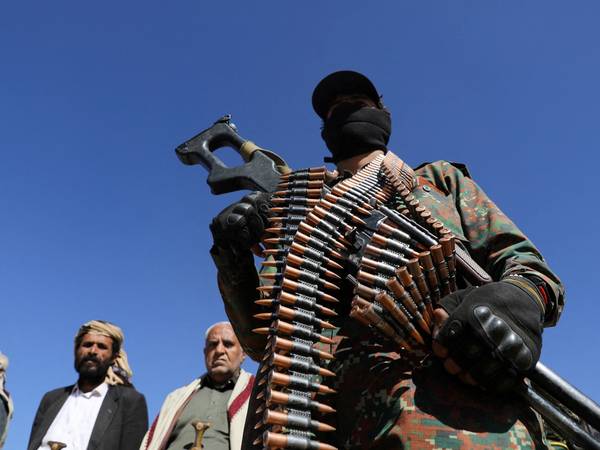Iran's regime dubs its regional armed groups "resistance forces," while opponents label them mercenaries. Many ordinary Iranians view them as terrorists who exploit their country's resources.
However, the term "proxies" employed by Western media and think tanks fails to accurately depict the diverse relationships these forces maintain with the regime. No section of Iranian society refers to them as na’eb or niabati (proxies).
The exact relationship with the regime
What truly defines the relationship between the Iranian regime and these entities often termed "proxies"? Are they allies, foreign terrorists fully integrated into Iran's operations, collaborators, mercenaries, or something else?
Allies: These are partners with whom Iran cooperates based on specific objectives, aiming for mutual benefits. This alliance may be strategic or tactical, subject to change over time with the evolution of agreements.
Assimilated Forces: This designation refers to groups fully integrated into the Iranian regime, demonstrating organizational ties, funding sources, ideological alignment, and shared political goals within their operational territories.
Recruited forces: These individuals are recruited by the Iranian government for short-term projects, lacking the comprehensive affiliation of assimilated forces. Their nationality or origin holds minimal significance in this context.
The forces employed by the Islamic Republic extend beyond mere mercenaries driven solely by financial incentives. For instance, groups like the Fatemiyoun (Afghan Shias) and Zainabiyoun (Pakistani Shias) harbor their own political agendas and aspirations. Notably, the Quds Force doesn't recruit non-Muslim or Western groups, instead favoring Shia or Sunni Islamists motivated by goals beyond financial gain. Many Afghan fighters, for example, seek Iranian citizenship while serving in Syria.
Labeling these groups as "proxies" fails to capture the nuanced relationship between the regime and its affiliated entities, a crucial distinction for policy-making. Should an assimilated Islamist organization, for instance, attack US forces, Iran's regime may be held accountable for retaliatory actions, unlike in the case of an allied group. To sidestep potential repercussions, Western governments often opt to categorize these groups as proxies.
Allies: Hamas and the Houthis
According to the outlined criteria, Hamas and the Houthis align with the Islamist regime as allies, given they are not religiously affiliated nor directly founded by the regime. Additionally, the Islamic Republic does not fully finance Hamas and the Houthis, who can partially sustain themselves. However, organizations like Islamic Jihad differ in this aspect. Established by the regime, Islamic Jihad operates within a limited territory in Gaza.
Recruited Forces: Fatemiyoun and Zeinabiyoun
While established and fully funded by the Islamic Republic, these military brigades lack territorial dominance and are more dependent on Tehran than those categorized as allies. Despite sharing religious affinity, they primarily serve as collaborators with the regime for a defined period. The Zeinabiyoun predominantly operate in Pakistan, while a significant portion of the Fatemiyoun forces remains stationed in Syria. There is no indication that they will be fully assimilated into the regime's structure.
Assimilated: Hezbollah and Hashd al-Sha`bi
Hezbollah, established by the regime, shares religious and ideological alignment and receives full financial support; its military branch is practically a Quds Force’s brigade. Similarly, while Iraqi Hashd al-Sha`bi's expenses are partially covered by the Iraqi government, their ideological alignment and coordination with the IRGC indicate domestication by the regime.
The military branches of these groups operate under the complete command of the Islamic Republic, even in micro decision-makings. The regime's influence over them was evident when the US threatened direct attacks on regime’s facilities in response to attacks on American personnel; the attacks ceased upon the regime's signal. None of these groups’ brigades operate independently, consistently aligning with official regime policies.
Hashd al-Sha`bi, initially established by the Quds Force and Iraqi military groups, maintains loyalty to the Islamist regime despite receiving funding from the Iraqi government. Their close ties to Iran and loyalty to the Guardian Jurist and IRGC commanders are evidenced by familial connections and frequent travel between Iran and Iraq.
Lebanon's Hezbollah fighters, one of the largest divisions of the IRGC, receives comprehensive support from Iran, including financial, logistical, and welfare assistance. Even the cost of rebuilding their destroyed houses in Israeli attacks is compensated. The intermarriage between Hezbollah fighters and regime officials' families underscores their symbiotic relationship, blurring the lines between Iranian and Lebanese identities. Hezbollah leaders likely possess Iranian documents, and Hezbollah members have been employed to suppress Iranian protests.
The political branches of Hezbullah and Hashd al-Sha`bi have their own agenda in Lebanon and Iraq as IRGC sections in Khorasan and Fars provinces have theirs. Any unit that works for IRGC, domestic or foreign, has its political and economic agenda and specific mission. The whole system is structured like a fiefdom: units are vassals and the Guardian Jurist (vali-ye faqih) is the lord.
